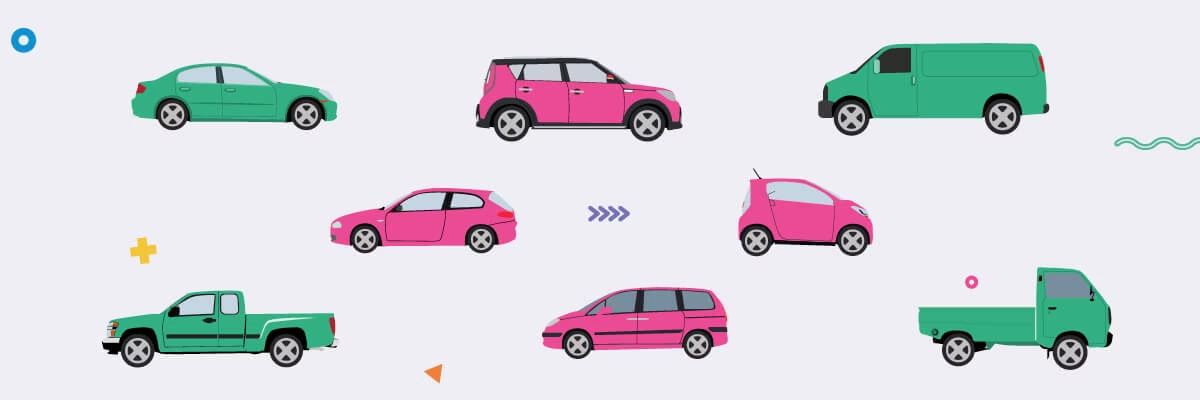As a hardworking tradie, chances are you rely on your trusty wheels for the job. And let’s be real, who doesn’t want to (legally) save money on their tax bill? If you’re not claiming all your vehicle expenses, you might be missing out!
But don’t worry – we’ve got you covered on what you can and can’t claim on your work vehicle, how to claim vehicle expenses, and what records you’ll need to keep for the ATO.
Let’s get claiming.
- What counts as a work vehicle?
- How to claim work vehicle expenses
- How to claim the purchase of a vehicle
- Let Hnry take the wheel (for your taxes)
What counts as a work vehicle for tax purposes?
Well for starters, the ATO breaks vehicles down into two categories:
Car
To claim work-related car expenses, the vehicle must actually, you know, be a car. The ATO defines this as a motor vehicle carrying less than 1 tonne and fewer than 9 passengers (including the driver).
Unsurprisingly, motorcycles and the like don’t count.
You’ll also need to be able to prove that you own or lease your car. If you use a family member’s car, and can show you’ve got a private arrangement to do this, you claim your expenses as if the car’s yours.
Other vehicles
Vehicles that are not cars include:
- Motorcycles
- Scooters and similar vehicles
- Vehicles exceeding a 1-tonne cargo capacity, such as trucks, heavy-duty vehicles, and some utes
- Vehicles designed to accommodate 9 or more passengers, including the driver, like minibuses.
But here’s the kicker: For both cars and other vehicles, you can only claim expenses related to the business usage of your vehicle.
So if you’re using your work ute to drive the boys to a party on Saturday night, you can’t claim that as a business vehicle expense – that’s personal usage.
Speaking of claiming –
How to claim work vehicle expenses
As a sole trader, you can use different methods to claim tax deductions depending on the type of vehicle you have.
- When claiming for a car, you can use either the cents per kilometre method or the logbook method.
- 💡 Note: you can’t claim depreciation on your car if you also use the cents-per-kilometre method, as this method already includes depreciation costs.
- When claiming for a vehicle other than a car you must use the actual costs method.
Let’s take a closer look at each one.
Cents per km method (car only)
This one calculation covers all your running expenses, including fuel, maintenance, and even depreciation!To calculate your claimable expenses using this method, you multiply the number of work-related kilometres travelled in the car by the rate per kilometre for the financial year, – for example, 88 cents per km for FY 2025/26.
You can claim a maximum of 5,000 work-related kilometres per car per financial year.
You don’t need to keep a logbook or receipts, but you need to be able to demonstrate car ownership, as well how you’ve worked out your work-related kms – like keeping note of these in a diary, or logging kilometres in an app.

Logbook method (car only)
To use the logbook method, you’re going to have to keep, well, a logbook.
A logbook is a handy document that spans at least 12 continuous weeks and paints a picture of your typical travel within the financial year.
To create a logbook, you’ll need to record the following details for every trip you take in a 12-week period:
- Destination and purpose (business or personal?) of each journey
- Odometer readings at the start and end of every trip
- Total kilometres you’ve travelled in that timeframe
- Odometer readings for the start and end of the logbook period.
Once your logbook is complete, you’ll need to calculate your business usage of your work vehicle based on the data you collected.
- Take the number of kilometres travelled for work-related trips
- Divide that number by total kilometres travelled
- Multiply that number by 100
You should be left with the business use percentage, which is the portion you can claim of your vehicle running costs.
💡 Note: if your work vehicle is 100% for work use, you still need to keep a logbook. Just to prove to the ATO that this is the case.
As well as details of your work-related trips, you’ll need to keep:
-
Receipts for fuel and oil expenses, or a documented reasonable estimate based on odometer readings
- Receipts for other car-related expenses, like
- registration,
- insurance,
- lease payments,
- services,
- tyres,
- repairs,
- electricity costs, and
- interest charges (phew!)
- A record of the car’s purchase price, and the method used to calculate its decline in value (we’ll get to this in a sec).

Actual costs method (all other vehicles)
For vehicles that aren’t cars, or aren’t yours, you’ll need to use the actual costs method. To do this, you:
- Calculate your actual expenses for work-related travel in the vehicle
- Claim the expenses in your tax return as a work-related travel expense (not as a car expense).
Although you can’t use the cents-per-kilometre or the logbook method for vehicles in this category, it’s worth maintaining a document similar to a logbook to determine your work-related use percentage.
While not mandatory, it’s an easy way to show how you calculated your work-related travel expenses.
How to claim the purchase of a vehicle
💡 Note: you can’t claim the purchase of a vehicle if you’re using the cents-per-kilometre method to claim vehicle expenses – it’s already included in the deduction amount!
If you’ve purchased a vehicle during the financial year you may be eligible to claim cost of your vehicle purchase under one of two methods:
- Instant asset write-off
- Depreciation
Instant asset write-off
With instant asset write off, you can claim a tax deduction on the cost of the vehicle immediately if you buy it between now and 30 June 2024, and pay no more than $20,000 (this is the current instant asset write-off threshold).
Depreciation
Certain assets, including vehicles, lose their value as they get older. This is known as depreciation. You can claim the cost of depreciation over time.
If you buy a vehicle between now and 30 June 2024, and pay more than $20,000, you’d claim depreciation by adding the vehicle to your small business pool.
📖 For more info on how to depreciate assets, check out our sole trader guide to depreciation.
How much can I claim for the purchase of my work vehicle?
If the business vehicle is a car, there’s a limit on the amount you can use to work out your depreciation claim. For 2023-2024 this limit is $68,108.
What this means is that if you buy a Tesla Cybertruck (… why?) for your business for $150,000, you can only claim depreciation on $68,108 of the full cost in your small business pool – provided the Cybertruck is for 100% business use. Again, you can only claim the business usage of work vehicles.
As you can see, this is complex stuff! Which is actually why Hnry exists – we want to make it easier for tradies to claim everything they’re eligible for. Sign up for Hnry, and we do depreciation for you.
Let Hnry take the wheel on your claims
As you can see, trying to figure out the world of tax deductions on your vehicle can be a real challenge.
Why wrestle with logbooks, depreciation rules, and complicated calculations when Hnry can handle it all seamlessly?
We’re an award-winning accounting app for sole traders just like you. We specialise in simplifying the complex, ensuring you get every dollar you deserve without the headache.
For just 1% + GST of your self-employed income, capped at $1,500 a year, Hnry will calculate and pay all your taxes, levies and whatnot for you, including:
Let Hnry take the driver’s seat when it comes to your tax so you can focus on what you do best – the actual work.
Share on:

